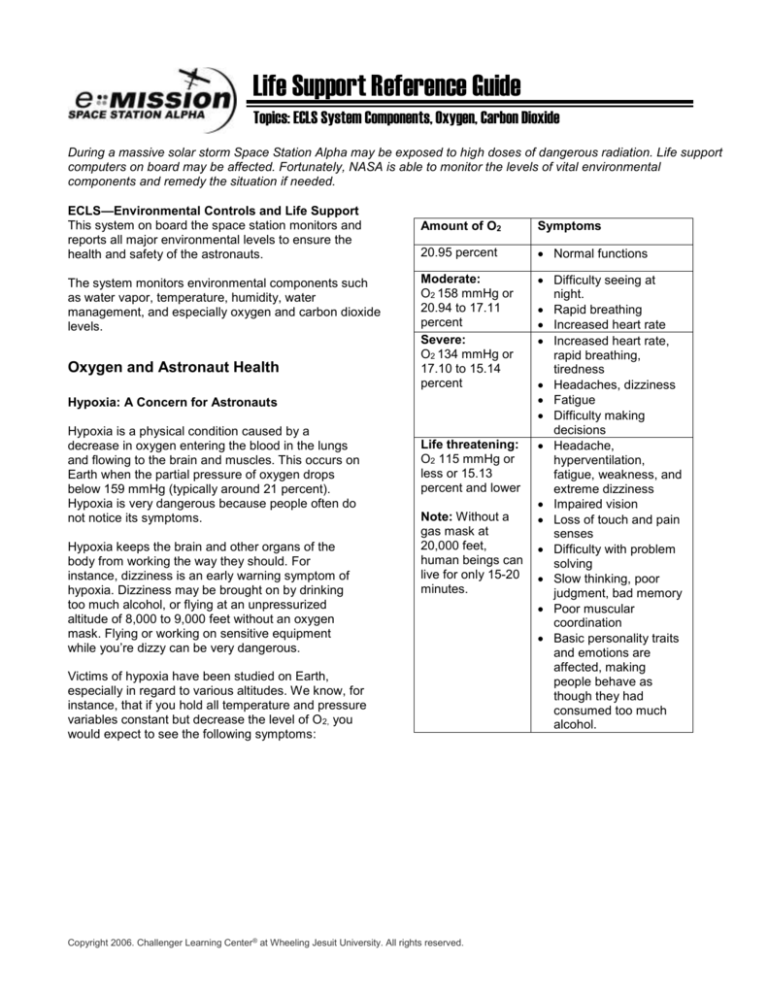
Life Support Reference Guide
Topics: ECLS System Components, Oxygen, Carbon Dioxide
During a massive solar storm Space Station Alpha may be exposed to high doses of dangerous radiation. Life support
computers on board may be affected. Fortunately, NASA is able to monitor the levels of vital environmental
components and remedy the situation if needed.
ECLS—Environmental Controls and Life Support
This system on board the space station monitors and
reports all major environmental levels to ensure the
health and safety of the astronauts.
The system monitors environmental components such
as water vapor, temperature, humidity, water
management, and especially oxygen and carbon dioxide
levels.
Oxygen and Astronaut Health
Amount of O2
Symptoms
20.95 percent
Normal functions
Moderate:
O2 158 mmHg or
20.94 to 17.11
percent
Severe:
O2 134 mmHg or
17.10 to 15.14
percent
Difficulty seeing at
night.
Rapid breathing
Increased heart rate
Increased heart rate,
rapid breathing,
tiredness
Headaches, dizziness
Fatigue
Difficulty making
decisions
Headache,
hyperventilation,
fatigue, weakness, and
extreme dizziness
Impaired vision
Loss of touch and pain
senses
Difficulty with problem
solving
Slow thinking, poor
judgment, bad memory
Poor muscular
coordination
Basic personality traits
and emotions are
affected, making
people behave as
though they had
consumed too much
alcohol.
Hypoxia: A Concern for Astronauts
Hypoxia is a physical condition caused by a
decrease in oxygen entering the blood in the lungs
and flowing to the brain and muscles. This occurs on
Earth when the partial pressure of oxygen drops
below 159 mmHg (typically around 21 percent).
Hypoxia is very dangerous because people often do
not notice its symptoms.
Hypoxia keeps the brain and other organs of the
body from working the way they should. For
instance, dizziness is an early warning symptom of
hypoxia. Dizziness may be brought on by drinking
too much alcohol, or flying at an unpressurized
altitude of 8,000 to 9,000 feet without an oxygen
mask. Flying or working on sensitive equipment
while you’re dizzy can be very dangerous.
Life threatening:
O2 115 mmHg or
less or 15.13
percent and lower
Note: Without a
gas mask at
20,000 feet,
human beings can
live for only 15-20
minutes.
Victims of hypoxia have been studied on Earth,
especially in regard to various altitudes. We know, for
instance, that if you hold all temperature and pressure
variables constant but decrease the level of O 2, you
would expect to see the following symptoms:
Copyright 2006. Challenger Learning Center® at Wheeling Jesuit University. All rights reserved.
Oxygen Generation
There are several ways to produce oxygen for the astronauts:
1) A machine called Elektron produces oxygen continually using “electrolysis.” It is powered by the solar panels
and batteries.
2) Perchlorate candles produce oxygen through a chemical reaction. Perchlorate (per-KLOR-ate) is packed
inside a metal canister, and the astronauts heat the canister to begin the reaction. Each canister releases
enough oxygen for one person for one hour in one room. Perchlorate is the same chemical used in the
breathing masks that drop down during emergencies on airplanes.
3) Astronauts can also use a portable breathing apparatus (PBA), which is like a gas mask. PBAs give the
astronauts 15 minutes of oxygen.
Carbon Dioxide and Astronaut Health
In the space station astronauts breathe out carbon
dioxide. It must be continually removed from the air in
the space station because it can be a danger to
astronauts’ health and safety if concentrations become
too high.
Air-circulation equipment and the carbon dioxide
removal systems constantly check and control the
levels of CO2.
Carbon Dioxide (CO2) Control
Lithium hydroxide (LiOH) canisters may be used in
an emergency to clean the air of CO2:
o
There are 10 canisters on board to be used
only in case of extreme emergency. These
canisters are stored in the Destiny module.
o
Each LiOH canister lasts about a day.
o
The canisters can only scrub 10 liters of air
per hour. One human generates 20 liters of
CO2 per hour.
o
Must use air fans to circulate the air
throughout the modules.
The carbon dioxide removal assembly moves
carbon dioxide from the air by using a material called
zeolite.
Copyright 2006. Challenger Learning Center® at Wheeling Jesuit University. All rights reserved.
Effects of CO2 on the Body
Severe to Life Threatening
Mild to Moderate
Symptoms
Concen- Pressure
Description
tration (mmHg)
0.03%
0.23
Normal carbon dioxide concentration in air on Earth.
0.37%
2.81
Average level of CO2 maintained on the Space Station—can reach as high as 0.7
percent
0.50%
3.80
Continuous exposure may be dangerous to the astronauts’ health, especially if
accompanied by lower levels of oxygen.
1.00%
7.60
The astronauts can suffer serious symptoms within an hour or two. Symptoms
include nausea, feeling hot and clammy, lack of attention to details, fatigue,
clumsiness, shaking, and vomiting.
2.00%
15.2
Severe headache after several hours exposure. Disrupted body functions resulting
in loss of energy and feeling run-down for several days.
3.00%
22.80
Astronauts can suffer serious symptoms almost immediately. If exposure persists,
they may pass out.
5 - 10%
38-76
Violent panting and fatigue to the point of exhaustion with severe headache. Can
result in irreversible effects to health, including death.
10 15%
77-114
Extreme panting, severe headaches and rapid exhaustion. Exposure for a few
minutes will result in unconsciousness and suffocation without warning.
25% to
30%
190-228
Coma and convulsions within one minute of exposure. Certain death.
Copyright 2006. Challenger Learning Center® at Wheeling Jesuit University. All rights reserved.









